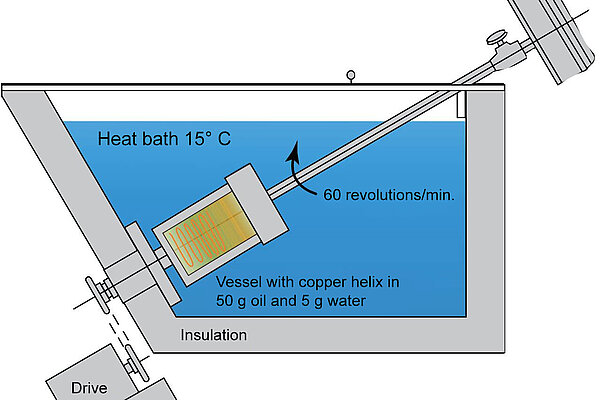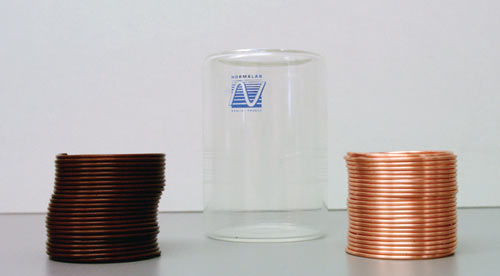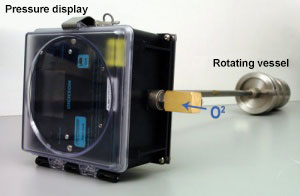RPVOT test - oxidation stability of lubricants
Year of publication: 2007
During their use, all oils age. During the oxidation process, oil molecules react with oxygen, among other things. Acidic reaction products and oil-insoluble components are formed. Elevated oil temperatures of over 60 °C, impurities and intensive air intake accelerate the aging process. To delay it as long as possible, additives with phenolic or aminic antioxidants or with salicylates are added to the lubricants. They can buffer and neutralize oxygenated compounds. However, if the additives are completely loaded and used up, the aging process of the oil accelerates almost unchecked.
In large circulation systems, such as turbines, paper machines or rolling mills, oils must be able to remain in service for several years. But gear oils of wind turbines and larger hydraulic oil fillings should also not be changed for far more than 20,000 bh. Therefore, their oxidation stability in particular plays an important role. The degree of oil oxidation or aging that has already occurred is usually determined by FT infrared spectroscopy. However, it does not allow reliable conclusions to be drawn about the oxidation stability still present and thus the remaining serviceability of the oil.
The RPVOT test (RPVOT= Rotating Pressure Vessel Oxidation Stability Test) provides a remedy. It tests the resistance of the fresh oil or the oil in service under extremely oxidizing conditions. In this way, a statement on possible oil change intervals can be made within a very short time.
For the test, 50 g of the oil in use and 5 g of distilled water are weighed into a reaction vessel. A previously polished copper coil is added to the oil-water mixture as a catalyst. The reaction vessel is tightly screwed into a pressure-resistant stainless steel container. The internal pressure of the pressure vessel can be permanently recorded on a manometer. The apparatus is now filled with pure oxygen to a pressure of 620 kPa.

The vessel with the copper coil and the water-saturated oil under oxygen pressure rotates at 150 °C with 60 revolutions. The heating initially causes an increase in the internal pressure in the pressure vessel. Subsequently, the extreme conditions (oxygen, copper, water, temperature) lead to oxidation of the test oil in any case. The oil absorbs oxygen in the process, and the originally set oxygen pressure within the pressure vessel decreases as a result. The oxygen consumption caused in this way is recorded as a pressure drop. The actual measured variable is the time span in which the internal pressure drops by 175 kPa below the maximum. The more time that elapses before this pressure drop, the more resistant the oil is to oxidation.
When comparing fresh oils, the test allows an assessment of their oxidation stability. Comparing the RPVOT value for the fresh oil with the value for the used oil, of which the operating time must be known, allows a forecast to be made of how long the used oil can remain in service in terms of oxidation until the oil is changed. This is of particular benefit to operators of turbines that are filled with very large quantities of oil. But the test can also be used to simulate the formation of sludge and residues in the oil, the formation of deposits on the surfaces of online sensors or the extension of oil change intervals when synthetic gear oils are used. Initial tests of lubricating greases have also already been carried out.
In addition to the tests with the RULER test on the degradation of the respective antioxidants (see ), the new RPVOT test contributes above all to the certainty of a statement on the further extension of the oil change interval. After all, a sudden dramatic drop in the oxidation stability of the oil can only occur if the conditions change unexpectedly. Thus, the RPVOT test not only makes it possible to determine the qualitative differences in aging stability of different oils, but also to control oil changes much more precisely than before.
A rule of thumb for oil aging:
At temperatures above 60°C, oil aging doubles for every 10°C.
Example: Service life for mineral oil-based hydraulic oils
| Oil temperature [°C] | Approx. operating time [h] |
| 60 | 40,000 |
| 70 | 20,000 |
| 80 | 10,000 |
| 90 | 5,000 |
| 100 | 2,500 |





